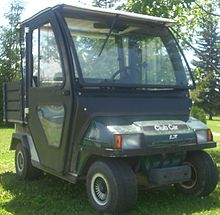- Club Car
-
Club Car, LLC Type Subsidiary Industry Golfing Founded 1958 Headquarters Augusta, Georgia, U.S. Key people Mark Dufour, President and CEO Products Golf cars Utility vehicles Parent Ingersoll Rand Website Club Car.com Club Car is the world’s largest manufacturer of small-wheel, zero-emissions electric vehicles.
Contents
Powertrain
From initial introduction of their gas powered golf carts, Club Car used a Kawasaki FZ340 9 horsepower engine until 1991. In 1992, it was replaced by a Kawasaki 286 cc FE290 9 horsepower engine, which was more powerful and efficient. In 1997, Club Car sourced new transaxles which required clockwise input. To remedy the issue, the engine's rotation was switched to clockwise, and displacement grew to 287 cc. In 2005, output increased to 9.5 horsepower (7.1 kW) and the FE290 engine then exceeded SAE J1940 performance standards. Output also increased for the 351 cc FE350 from 11 horsepower (8.2 kW) to 11.5 horsepower (8.6 kW). It too exceeded the SAE J1940 standard
The options on Club Car's golf carts are the Kawasaki FE350 11.5hp (standard on many utility vehicles and the Precedent golf cart) and a Kawasaki FE400 13 hp engine, which is the only engine offered on the Carryall 272 utility vehicle.
Bodies
When first introduced in 1982, the Club Car DS front and rear body panels were constructed of plastic and fiberglass, respectively. In 1993, Club Car redesigned the bodies and began constructing both the front and rear panels out of a material called ArmorFlex. ArmorFlex is thicker and stiffer than the materials used by other manufacturers. The result is a smoother appearance; however, this characteristic also makes the panels break, rather than bend, when hit in certain ways. Generally, ArmorFlex panels must withstand prolonged abuse before breaking.
With the introduction of the Precedent golf car in late 2003, Club Car implemented DuPont's Surlyn material for the Precedent body panels. The material that also covers some golf balls, Surlyn has its color molded in. No paint or clear topcoat is needed on the Surlyn panels.
Frame
From introduction of the 4-wheeled Caroche cart in the 1970s, an aluminum I-beam style frame has been used, and is still under the DS and many utility vehicles that are manufactured today. For gasoline vehicles made from 1984 to 1997, the frame consists of four I-beams. Two span from the extreme front of the cart to a mid-car cross member. Two placed to the outside of those run from the front of the floorboard to the rear extreme. In using that design, the beams did not need to be bent in more ways than one. From 1998 to present day, the cars implement two beams that span the entire length of the vehicle and must be bent laterally as well as vertically. However, the result is a stronger frame with fewer welds. Electric cars have always used but two beams that span the entire length of the car.
The Precedent cart uses an aluminum box-tube style frame, which, with modifications, also underpins the line of XRT 4 wheel drive vehicles. The Precedent frame is extremely similar to the design of the DS, but does not use as much aluminum for it uses a composite panel that underpins the floorboard and parts of the engine or battery compartment. This member is friction-bonded to the rest of the carriage.
Suspension
Since the introduction of the Caroche four-wheeled car, Club Car has used essentially the same suspension. The system offers simplicity and durability, as well as ease of manufacturing and maintenance.
In the front of the car, the two frame beams are sandwiched between a leaf spring on the bottom and a delta shock tower assembly on the top. The leaf spring is sandwiched between a plate mounted directly against the frame and a lower support plate. Mounted to the upper delta shock tower assembly, two delta A-plates (a variation of a control arm) connect the top of the king pin and the pivots of the delta A-plate. The setup acts as an upper and lower control arm system without the complexity of coil-over shocks, struts, or double wishbone types of suspension. Club Car is now the only manufacturer to use leaf springs for both the front and rear suspensions.
The rear suspension is classified as semi-independent since the rear axle, transmission, and engine are all connected together and are held in place only by leaf springs and shock absorbers. The front of the drive train assembly is not fixed, rather if floats and is free to move in any way necessary.
External links
- Company Website
- Club Car Golf Carts Recall, U.S. Consumer Product Safety Commission
Categories:- Companies established in 1958
- Companies based in Augusta, Georgia
Wikimedia Foundation. 2010.

